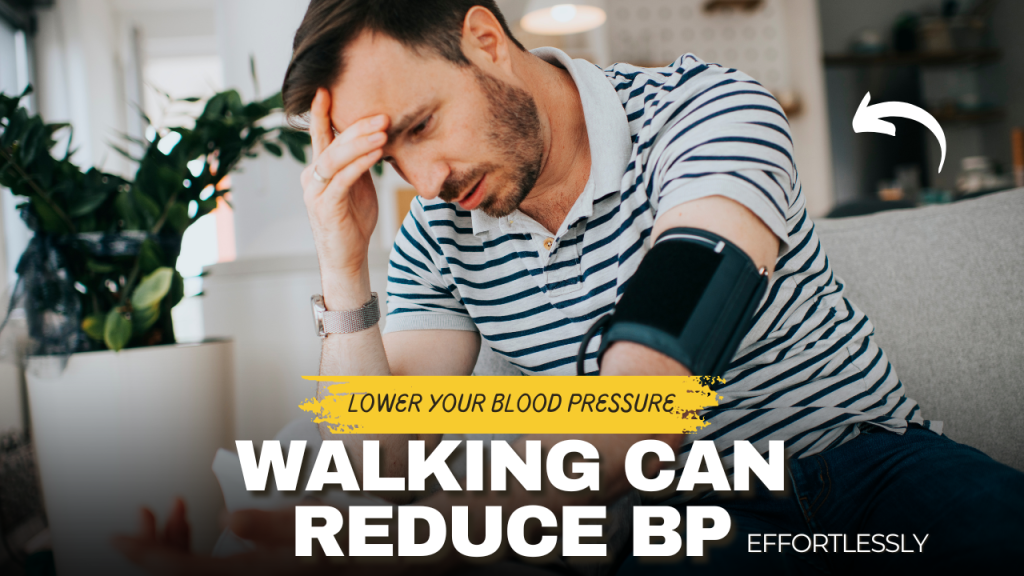Did you know that something as simple as walking could be your natural solution to lowering blood pressure without relying on medication? If you’re one of the millions of people who struggle with hypertension, you’re not alone. But instead of turning straight to medication, consider incorporating a simple, cost-free, and highly effective strategy into your daily routine: walking.

What Can Happen After 30 Days of Walking to Lower Blood Pressure?
| Week | What Can Happen |
|---|---|
| Week 1 | – Improved circulation and blood flow |
| – Reduction in stress levels | |
| – A slight drop in blood pressure for some individuals | |
| – Increased energy levels from regular movement | |
| Week 2 | – Noticeable reduction in anxiety and mental fatigue |
| – Enhanced heart health and endurance | |
| – Consistency begins to form as a habit | |
| Week 3 | – Greater flexibility in joints |
| – Enhanced mood and mental clarity | |
| – Further drop in blood pressure, especially for those who were mildly hypertensive | |
| Week 4 | – Significant weight loss, especially if combined with healthy eating |
| – Visible improvements in cardiovascular health | |
| – Lower blood pressure readings for many individuals, potentially reducing medication needs (consult with a doctor) | |
| – Established walking routine that has become a sustainable part of daily life |
By the end of 30 days, you may experience noticeable improvements in both your physical and mental health, including lower blood pressure, improved mood, and increased energy. The key is to stay consistent and combine walking with other healthy habits.
Understanding High Blood Pressure
High blood pressure, or hypertension, is often called the “silent killer” because it usually has no symptoms, yet it increases your risk for serious conditions such as heart disease, stroke, and kidney damage. It’s a growing health concern that affects about 1 in 3 adults worldwide. Managing blood pressure effectively is essential for overall health, and the good news is that you can take control with lifestyle changes.
The Science Behind Walking and Blood Pressure
Walking has a profound impact on cardiovascular health, and the positive effects on blood pressure are backed by science. Regular physical activity, such as brisk walking, improves circulation, strengthens the heart, and helps blood vessels function better. When your heart is stronger and your blood vessels are more flexible, the force exerted on your arteries (which is your blood pressure) decreases.
How Walking Lowers Blood Pressure
- Increased Circulation
Walking regularly boosts your circulation, ensuring that blood flows more smoothly through your arteries. This improves the overall functioning of your cardiovascular system and reduces the resistance your heart faces when pumping blood, ultimately lowering blood pressure. - Stress Reduction
One of the most underrated benefits of walking is its ability to relieve stress. Stress is a significant contributor to high blood pressure, and walking helps reduce levels of cortisol, the stress hormone. A peaceful stroll or even a brisk walk in nature can clear your mind and offer significant stress relief, which directly impacts your blood pressure. - Improved Heart Health
Walking strengthens your heart muscle. A stronger heart is able to pump blood more efficiently, which means it doesn’t have to work as hard to move blood throughout your body. Over time, this can lower your resting blood pressure. - Weight Management
Excess weight, particularly belly fat, is a major contributor to high blood pressure. Walking helps burn calories and promotes fat loss, leading to weight management and a lower risk of hypertension. Studies have shown that even modest weight loss (as little as 5-10% of body weight) can have a significant impact on lowering blood pressure. - Better Insulin Sensitivity
Insulin resistance is another factor that can contribute to high blood pressure. Regular walking improves insulin sensitivity, which helps regulate your blood sugar levels and reduces the risk of high blood pressure caused by metabolic dysfunction.
How Much Walking Do You Need?
You don’t need to go for long, intense walks to start seeing the benefits. In fact, studies have shown that just 30 minutes of brisk walking a day, spread out over at least five days a week, is enough to make a difference in lowering blood pressure.
The key is consistency. Incorporating walking into your daily routine, even in small increments (like taking the stairs instead of the elevator or parking further from the store), can add up over time and lead to noticeable improvements.
Do You Know?
Walking isn’t just beneficial for those with high blood pressure—it also works wonders for those at risk of developing it. A study from the American Heart Association found that walking for just 30 minutes a day can help prevent high blood pressure and significantly reduce the likelihood of developing heart disease.
Myths About Walking and Blood Pressure
- Myth: Walking Isn’t Intense Enough to Lower Blood Pressure.
Walking is a moderate-intensity exercise that can still have a significant impact on lowering blood pressure. You don’t have to run a marathon to enjoy the benefits of walking. - Myth: You Need to Walk for Hours to See Results.
While more walking is better, the truth is that even short daily walks (15-30 minutes) can help lower blood pressure over time, especially when combined with other healthy habits. - Myth: Blood Pressure Medication is the Only Solution.
While medication can certainly be helpful for managing blood pressure, lifestyle changes—such as walking—can be just as effective in the early stages of hypertension, and in some cases, can reduce the need for medication.
Walking for All Ages
The beauty of walking is that it’s suitable for everyone, regardless of age or fitness level. Whether you’re in your 20s or over 60, walking can be adapted to fit your lifestyle. Older adults, especially those with arthritis or other mobility issues, can also benefit from low-impact walks that are easy on the joints.
For those new to exercise or with existing health conditions, it’s always a good idea to consult with your healthcare provider before starting a new exercise routine. They can offer guidance on the best walking schedule for your specific needs.
Interesting Fact: Walking and Nature’s Healing Power
Studies have shown that walking in nature, such as in parks or green spaces, can have even more profound effects on lowering blood pressure. Nature walks have been linked to reductions in stress, anxiety, and even depression. This type of walking doesn’t just benefit your blood pressure, but also your mental health.
Conclusion: A Simple Step to Health
Walking is one of the simplest, most accessible, and most effective ways to naturally lower your blood pressure without relying on medication. By committing to a regular walking routine, you can improve circulation, reduce stress, maintain a healthy weight, and enhance your heart health—all of which contribute to better blood pressure regulation.
Incorporating this easy habit into your daily life might be the key to managing your blood pressure and improving your overall health—without the need for expensive medications or complex treatments. So, put on those comfortable shoes, step outside, and take the first step toward a healthier you.
Frequently Asked Questions (FAQs)
How long should I walk to lower my blood pressure?
To effectively lower your blood pressure, aim for at least 30 minutes of brisk walking a day, ideally five days a week. If you can’t commit to 30 minutes at once, breaking it up into shorter 10-15 minute sessions can still provide benefits.
Can walking alone replace medication for high blood pressure?
While walking can significantly help in lowering blood pressure, it’s essential to speak with your doctor before making any changes to your treatment plan. In some cases, walking combined with other lifestyle changes may allow you to reduce your reliance on medication. However, always consult with your healthcare provider for personalized advice.
What’s the best time of day to walk for lowering blood pressure?
There isn’t a specific time that works better than others, but it’s important to find a time that fits into your routine. Whether in the morning, afternoon, or evening, consistency is key. Some people find that walking in the morning helps them feel energized, while others prefer evening walks to wind down.
How fast should I walk to see results?
To see significant results, aim for a brisk pace, which is about 3 to 4 miles per hour. If you can still talk but feel a bit out of breath, you’re likely walking at the right intensity. If you’re just starting out, begin with a comfortable pace and gradually increase your walking speed.
Can walking in nature make a difference for my blood pressure?
Yes! Walking in nature, such as parks or green spaces, has been shown to offer additional mental health benefits, including reduced stress and anxiety. These benefits can further help in lowering blood pressure, making nature walks an excellent choice for relaxation and health improvement.
Are there any risks with walking for people with high blood pressure?
For most people with high blood pressure, walking is a safe and beneficial exercise. However, if your blood pressure is very high (e.g., over 180/110 mmHg), it’s important to speak to your healthcare provider before starting any exercise. They can help determine the best approach based on your specific health needs.






Awesome
Awesome
Good